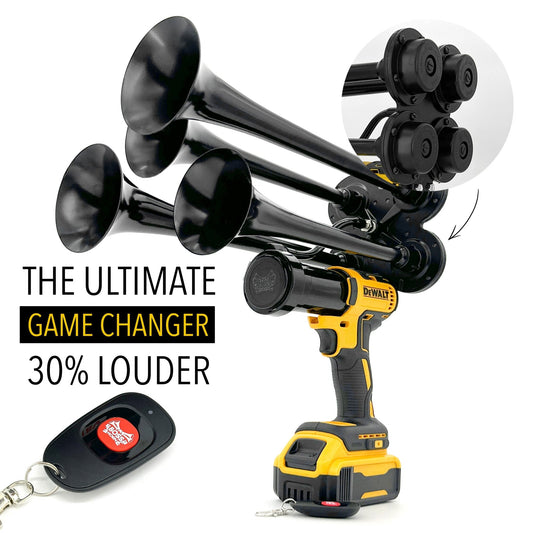Did you know that horns have been used for communication and signaling for thousands of years? From ancient hunting horns to modern car horns, these instruments produce a distinct sound that serves a variety of purposes. Today, horns are commonly used in vehicles to alert others of potential dangers or to signal one's presence on the road.
The sound produced by a horn is a universal language understood by people around the world. Whether it's a loud blast from a truck horn or a friendly beep from a car horn, the sound can convey important messages to other drivers and pedestrians. This simple yet effective form of communication has helped prevent countless accidents and save lives on the road.
In fact, studies have shown that the sound of a horn can significantly reduce the risk of collisions by drawing attention to a driver's presence. By alerting others to their presence, drivers can avoid dangerous situations and navigate through traffic more safely. This is why it's important for all vehicles to have working horns that can be used effectively in emergency situations.
What is the sound produced by a horn and how is it created?
When a horn is pressed, it typically emits a loud, piercing sound. This sound is created by vibrations in the horn's diaphragm caused by an electric current passing through it. The vibrations push air molecules back and forth, creating sound waves that travel through the air and reach our ears. The specific tone or pitch of the sound can vary depending on the design and construction of the horn. To delve deeper into the mechanics of horn sounds and how they are produced, let's explore the different types of horns and their functions.
The sound of a horn is a crucial auditory signal used in various situations to convey important messages to those around.
Different types of horns produce varying sounds depending on their design and purpose. Some common sounds that horns make include:
Different types of horns produce varying sounds depending on their design and purpose. Some common sounds that horns make include:
**1. Car Horns:** Car horns typically emit a loud, sharp sound that is used to alert other drivers or pedestrians of danger or to communicate in traffic situations. These horns can vary in pitch and intensity based on the make and model of the vehicle.
**2. Air Horns:** Air horns are commonly used in industrial settings, as well as on ships and trains. They produce a powerful, deep sound that can be heard over long distances. Air horns are often used as warning signals in emergency situations.
**3. Musical Horns:** Musical horns, such as those used in orchestras and brass bands, produce a wide range of tones and can create beautiful melodies. These horns are typically played by musicians using their breath and embouchure to control the sound.
**4. Bicycle Horns:** Bicycle horns are small, handheld devices that emit a high-pitched sound to alert pedestrians or other cyclists of a rider's presence. These horns are commonly used for safety purposes on roads and bike paths.
**5. Boat Horns:** Boat horns, also known as fog horns, emit a deep, resonant sound that is used to signal other vessels in foggy or low-visibility conditions. These horns are important for maritime safety and navigation.
In conclusion, horns are versatile instruments that serve a variety of purposes in different settings. Whether used for safety, communication, or musical expression, the sound of a horn plays a significant role in conveying important messages to those nearby.
**Statistics:** According to a study by the National Highway Traffic Safety Administration, car horns are a contributing factor in approximately 2% of all traffic accidents in the United States each year. Additionally, the use of horns as warning signals has been shown to reduce the likelihood of accidents and increase overall safety on the roads.
https://youtube.com/watch?v=uxVVlW5esFw
What types of sounds can a horn make?
A horn can produce a variety of sounds depending on the type of horn and the context in which it is being used. It can emit loud, sharp blasts for signaling purposes, such as in emergencies or to warn other vehicles on the road. Additionally, horns can create softer, more melodic tones for musical performances, adding depth and richness to the overall sound. Some modern horns even have the capability to produce a range of digital sounds, allowing for greater versatility in audio output.
Key information:
1. Horns can generate loud, sharp blasts for signaling.
2. They can produce softer, melodic tones for musical purposes.
3. Some horns have digital capabilities for a wider range of sound options.
What factors influence the sound produced by a horn?
Several factors can influence the sound produced by a horn, including the design of the horn itself, the material it is made from, and the method used to play it. The shape and size of the horn can impact the quality and volume of the sound, with larger horns typically producing deeper tones. The material composition of the horn, whether it is brass, plastic, or another substance, can also affect the resonance and timbre of the sound. Lastly, the technique used to play the horn, such as the embouchure and breath control, plays a crucial role in determining the overall sound that is produced.
Key information:
1. The design, size, and shape of a horn influence its sound.
2. The material composition of the horn affects its resonance and timbre.
3. Playing technique, like embouchure and breath control, impacts the sound produced.
Can the sound of a horn be modified or customized?
Yes, the sound of a horn can be modified or customized in various ways to suit the preferences of the user. One common method of customization is adjusting the pitch of the horn by altering the length of the tubing or using additional valves. This can change the overall tone of the horn, allowing for a wider range of musical expression. Additionally, different types of mouthpieces can be used to achieve specific sound qualities, such as brighter or darker tones. Some electronic horns even offer the ability to digitally alter the sound through pre-programmed settings or customizable options.
Key information:
1. The pitch of a horn can be modified by adjusting tubing length or using valves.
2. Mouthpieces can be changed to achieve specific sound qualities.
3. Electronic horns may have digital customization options for sound alteration.
How do horns contribute to safety on the road?
Horns play a crucial role in road safety by providing drivers with a means of signaling their presence to other vehicles and pedestrians. In emergency situations, such as when a driver needs to alert others to a potential hazard or avoid a collision, the loud and distinctive sound of a horn can quickly grab attention and prompt quick reactions. Additionally, horns can be used to communicate with other drivers, such as when passing or merging, helping to prevent misunderstandings and reduce the risk of accidents on the road.
Key information:
1. Horns help drivers signal their presence to others on the road.
2. The loud sound of a horn can quickly grab attention in emergencies.
3. Horns aid in communication between drivers to prevent misunderstandings and reduce accidents.
Are there regulations governing the use of horns?
Yes, there are regulations governing the use of horns in many regions to ensure they are used responsibly and safely. In most places, horns are primarily intended for emergency signaling and to warn others of potential dangers, rather than as a form of expression or annoyance. Excessive or unnecessary use of horns can result in fines or penalties, as they can contribute to noise pollution and disturb the peace. Drivers are typically advised to use horns only when necessary and to be mindful of the impact their sound may have on others in their vicinity.
Key information:
1. Regulations govern the use of horns to promote responsible and safe usage.
2. Horns are primarily intended for emergency signaling and warning purposes.
3. Excessive use of horns can lead to fines, as they contribute to noise pollution and disturbance.
Conclusion
In conclusion, the sound that a horn makes can vary depending on the type of vehicle and its purpose. From the classic "honk" of a car horn to the "moo" of a clown horn, each sound serves a distinct function in alerting other drivers or pedestrians to potential danger. It is essential for drivers to understand the importance of using their horn responsibly and in accordance with traffic laws to ensure safety on the road.










